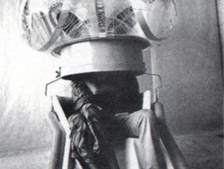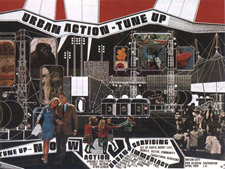Rodrigo Alonso
 |
|
 |
Haus-Rucker-Co. Mind Expander I.
Industrial design. 1967. |
 |
Archigram. Instant City.
Urban Action Tune-Up. Collage. 1969. |
 |
With the development of industrialization and capitalism, the world has experienced a deep, but to a certain extent, paradoxical transformation. If, on the one hand, new technological discoveries have multiplied communications, dissolving geographical distances, on the other, life has tended to converge on the cities, where political and economic powers have also clustered. Modernity is marked by urban experience. Nature has become relegated to the nostalgic gaze of the romantic poets or the evanescent landscapes of impressionist painting. The city takes shape as the model of community life, and its organization is as much a reflection of the will to rational domination of nature which capitalism and science undertake, as it is a system for the control of the growing urban masses.
Within this tendency, the duality is revived between nature (phisis) and city (polis), around which the Greek world, the model for modern democracies, was organized. But throughout the 20th century a new factor appeared, displacing these two aspects, which until then seemed to be the most complete description of the human sphere. Mass media offered a new and artificial milieu, where nature and city are subsumed by the domain of representations, to the extent that, for thinkers such as Jean Baudrillard, it seems to erase any trace of the previous modern world.
This decisive point in the discussions about post-modernism recurs with the advent of information technology. This not only makes possible the translation of reality by the media, but also the creation of a new environment which expands the frontiers of the known physical and political realms. To what extent this expanded space replaces or complements the former ones is still under debate. But it seems certain that in the area of information networks, genetic engineering, artificial intelligence and artificial life, there has been a transformation of the traditional notions of nature and society.
To speak of an information universe is perhaps an exaggeration, in that the technology which sustains it changes at a dizzying pace, modifying its parameters all the time. In any case, if this universe exists, we can say that its essence is fluid and unstable, variable and fluctuating. We could even regard such instability as integral to its logic and that regularity and stability have evaporated with modern thought. In any case, it’s clear that the digital world currently presents itself as a space of potential creation. And as a place full of promise, it arouses the interest of artists and utopian thinkers who see in this unfolding universe an opportunity to produce new connections with nature and the city, alternative realities and untried community experiences. For some approaches, like cyber-feminism, participation in the construction of this realm also means deconstructing cultural archetypes, historical legacies and social attitudes rooted in the real world, with a view to creating areas of true egalitarian conviviality. Thus, the new space is a field of creation and reflection as much for art, design and architecture, as for sociology, politics and philosophy.
EXPANSIVE CHRONICLES
In the midst of a media society, at the decade of the 60s, the attitude of artists toward technology was still contradictory. While some of them looked for ways to oppose its effects by fostering non-media modalities like performance, others decided to explore the possibilities of new media such as video and computers. In his book, Beyond Modern Sculpture (1968), Jack Burnham examines art films, luminous sculpture, robotics and cybernetic art as new sculptural practices. And in the context of this expanding wave the term expanded cinema was coined to characterize a growing number of proposals aimed at the expansion of cinematic experience.
Expended cinema aimed, above all, to neutralize the linear narrative of film to the benefit of its visual pre-eminence. To that end, the multiplication of screens, the use of light as an aesthetic agent, the abolition of the boundaries between artistic modes, the stimulation of the public’s corporeality, and the free play of cinematographic techniques were all proposed. The term was revived in a now classic text, Expanded Cinema (1970) by Gene Youngblood. In it, the author welcomed the alliance of film with video and computers, and speculated about the potential of holographic projections. For Youngblood, the main point of these experiences was their synesthetic character, their capacity to capture the public’s attention through sensation, producing expanded states of consciousness.
Avant-garde architects and designers at the time were pursuing the same objectives. In the various versions of Mind Expander (1967-69), the Viennese group Haus-Rucker-Co at-tempted to wrench people from their immediate environment by drawing them into a universe of sensations. The sensorial bombardment was, in reality, an aspect of the media world that architects such as the Archigram group would also explore. Their projects were saturated with images, posters, screens, changes of scale, spatial devices, loudspeakers and luminous letters that make the limits of the traditional modern city burst apart, foreshadowing the later notions of cybercities. In 1978 Rosalind Krauss’ influential essay, Sculpture in the Expanded Field, was published. There, the author highlights the creation of works that hover between landscape and architecture, dissolving the line between artistic practices and cultural activity.
LIQUID ARCHITECTURES, INMERSION, AND VIRTUAL REALITY
Architecture, as a model of the human capacity for the construction of artificial milieus, has been a privileged explorer of the spatial expansion which has accompanied the information revolution. An architecture of data, composed of routes and accesses, nodes and information highways, has emerged. William Gibson, who created the concept of cyberspace in his novel Neuromancer (1984), compares it to the city of Los Angeles viewed from the air. Since then, the image of a de-centered field, reticular and fragmented, has become the basic description of the cyberspace realm.
This expanded space is subsidiary to computers and digital networks, which translate the urban metaphor into an entirely disembodied architecture. It’s symptomatic that, nearly contemporary with the appearance of the term cyberspace, the philosopher Jean-Francoise Lyotard curated a show at the Georges Pompidou Center in Paris called Les Immatériaux (1985), examining the impact of the new technologies on various human activities, in particular on art and architecture. Lyotard theorized the apparition of a new kind of materiality, which he called immaterial, and which is integral to electronic art. These immaterials disrupt the traditional relations of humans with nature, in which the first establish their supremacy over the second through their dominance of matter.
Computers replace humans in this function through the manipulation and control of information. Thus, according to the French philosopher, “the model of language replaces the model of matter,” and the notion of a stable substance is substituted by the unstable concept of interaction.
Some years later, Marcus Novak proposed liquid architecture as a structural model of cyberspace, defining it thus: “Liquid architecture is an architecture that breathes, pulses, leaps from one form and lands as another. Liquid architecture is an architecture whose form is contingent on the interests of the beholder; it is an architecture that opens to welcome me and closes to defend me; it is an architecture without doors or hallways, where the next room is always where I need to be it and what I need it to be.” From this description it follows that the principal characteristic of this space is its mutability and malleability; the permanence and stability seek by the modern city are no longer there. Less obvious, but no less important, is its shifting and interactive aspect: an architecture that no longer grows only in terms of space but also of time; places that don’t define beforehand the possible demands of the users but which adapt to them.
These properties of cybernetic expanded space is behind the interactive installations and other works for information networks of those artists most involved with the nature of these new technologies. Interactivity has become a fundamental aspect, not only because of the protagonism it bestows on the user, but above all because it reveals the mutable essence of digital space, its constant variability and evolution. There exist, nevertheless, many other ways to express this aspect; for example, the use of alogorhythms that produce structures that self-replicate, or random systems where chance determines the final configuration of the data that create a virtual space. These options prolong the displacement of humans from their center of power in the world (as Lyotard affirmed) but also open doors to possible universes beyond the limitations of human mind and imagination.
Nonetheless, humans continue to be the principle recipients of these creations, at least in the domain of artistic production. The rapid rate of the development of interfaces and visualization systems prove that. These devices are required to ensure the link between the cybernetic universe and that of the user, opening the gates to virtual space. A clear trend in this respect is the replacement of physical interfaces by dematerialized mechanisms that present a more direct relation to data and graphics. The transparent touch-sensitive screens of the movie Minority Report (2002) are an example of a currently available technology that hasn’t become ubiquitous due to its high cost. A more common case in the arts is the creation of immersion environments, where spectators enter a simulated universe with the possibility to manipulate images and virtual objects in real time. The CAVE system, developed by the University of Illinois (Chicago, USA) is one of the best known and widely used. It consists of a room with space for several people, equipped with three-dimensional, high resolution video projectors and surround sound. The system successfully replaces virtual reality technologies common in the 80s, that required helmets and data gloves (which were uncomfortable for users), but it still has the disadvantage of being a rigid structure and difficult to move, in an epoch in which mobility seems indispensable.
As an alternative, many artists work with virtual reality systems made for data networks, such as VRML (Virtual Reality Markup Language). Although it doesn’t have the immersive capacity of physical environments, it provides an effective visualization of virtual three-dimensional spaces, easily navigable using widely available software. These environments are adaptable to multiple users, which permits people at different places on the network to be in a site simultaneously, generally via avatars (representations of the user in cyberspace). They can also include chat rooms, the possibility to manipulate images and objects, and even contact with the other connected visitors via web-cams and microphones. The widest use of these systems currently is for web-based video games, but they’ve been used equally by both scientists and artists, with the aim of prolonging even further the scope of a space still in expansion. |
Published in:
art.es, 6-7, Madrid, November 2004/February 2005.
|

